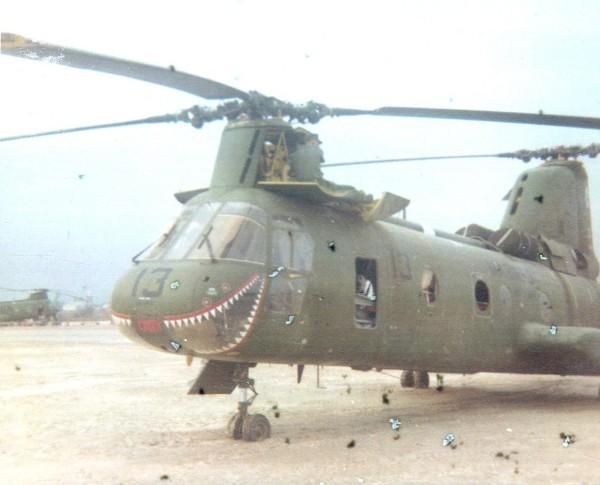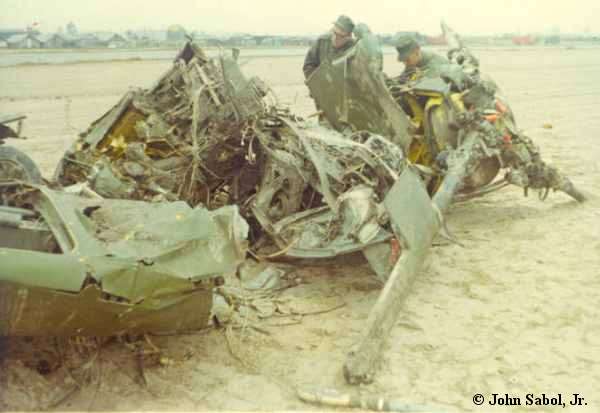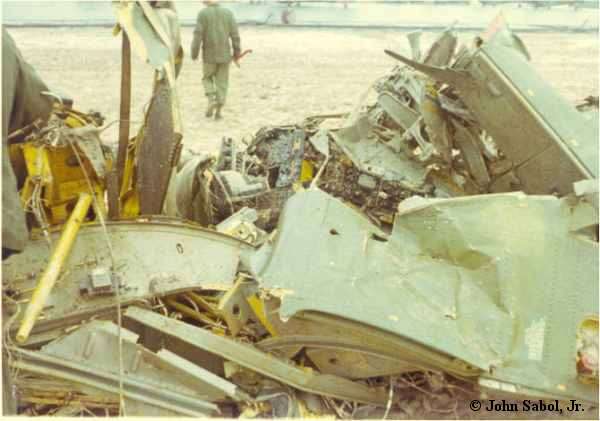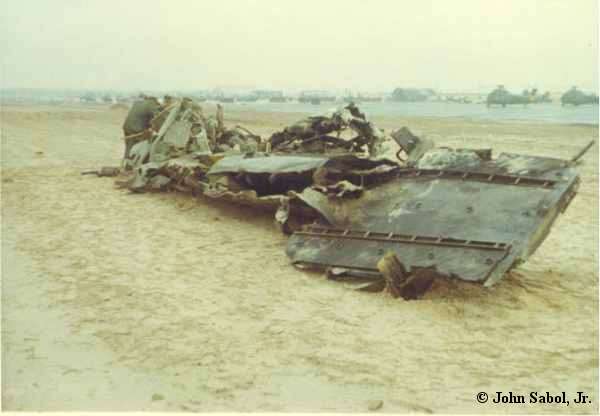Medevac Helo Destroyed Near Hue City
Demko, Leonard Richard, Maj.
Burke, John Joseph, Capt.
Conner, Gerald William, Cpl.
Shelton, James Dallas, Sgt.
Copeland, Norman Ottis, Cpl.
Ehrhardt, Jack Sparky, HN |
(Pilot)------
(Copilot)
(Crew Chief)
(Gunner)
(Gunner)
(Corpsman) |
(Index)
(Index)
(Photo)
(Photo)
(Photo)
(Index) |
 On
Friday, February 5, 1968 the above crew of YK-13,
Bureau Number 153986, was tasked for a medical evacuation (medevac) in
the vicinity of Hue City. As the aircraft approached the landing
zone it was hit by an unknown number of small arms/automatic weapons rounds
prior to picking up the three seriously wounded Marines. Since the
mission was rather close to the HMM-364 base at Phu Bai, operations could
monitor the radio traffic. Maj. Demko radioed that they had been
hit and the hydraulic and control systems were affected. They were
still at a low altitude when the aircraft pitched up, rolled inverted and
crashed at coordinates YD 790230. The escort gun ship helicopter
landed and rescued the injured from the crashed CH-46D. A squadron
maintenance team retrieved the wreckage with another CH-46D. It was
a shocking chain of pieces held together with pipes and cables that bore
no resemblance to a helicopter.
On
Friday, February 5, 1968 the above crew of YK-13,
Bureau Number 153986, was tasked for a medical evacuation (medevac) in
the vicinity of Hue City. As the aircraft approached the landing
zone it was hit by an unknown number of small arms/automatic weapons rounds
prior to picking up the three seriously wounded Marines. Since the
mission was rather close to the HMM-364 base at Phu Bai, operations could
monitor the radio traffic. Maj. Demko radioed that they had been
hit and the hydraulic and control systems were affected. They were
still at a low altitude when the aircraft pitched up, rolled inverted and
crashed at coordinates YD 790230. The escort gun ship helicopter
landed and rescued the injured from the crashed CH-46D. A squadron
maintenance team retrieved the wreckage with another CH-46D. It was
a shocking chain of pieces held together with pipes and cables that bore
no resemblance to a helicopter.
Photos by, Cpl. John Sabol, Jr.
For larger versions click on the above images
Information available to the web master indicates that
Cpl. Connor survived the crash, was rescued by the chase aircraft and delivered
to a medical facility in the area. It appears Cpl. Connor was then
transferred to the USAF Hospital, Cam Rahn Bay where he eventually died
fifteen days later on February 20, 1968.
For thirty three years the fate of the Navy Corpsman
remained unknown other than he was critically wounded. During November
2000 Kelly Lea, who is the niece of Major Leonard R. Demko, became aware
of this web site dedicated to the Marines of HMM-364 and directed her efforts
toward locating the sole survivor of this terrible incident. Kelly
turned to the "power of the internet" and posted several requests for additional
information relative to the crash of YK-13 on various sites dealing with
the Vietnam War. An employee of the Erie Veterans Affairs Medical
Center of Erie, PA. read her posting and believed that a friend of his,
Jack Ehrhardt, well could have been the Corpsman in question. What
follows is Jack "Doc Sparky" Ehrhardt's memories of that fateful day.
We launched for the third or fourth time that day
in response to three emergency medevacs in the vicinity of Hue City.
We were flying low level and jinxing left
and right to avoid enemy gunners being able to draw a good sight picture
on the aircraft. We had been airborne for a very few minutes when
Maj. Demko initiated another left hand turn which rolled the aircraft to
a position that allowed me a view of some troops on a road we were flying
along. The aircraft then rolled over to the right and all I saw was
the sky followed by another turn to the left which, to my surprise gave
me a view of those same troops seen earlier firing upon us. I grabbed
my M-14 and took a few shots out the left side of the aircraft. We
moved beyond their effective range but very soon we were taking fire again
from another source. As I sat on the troop seat seeking the
source of the rounds which were plinking through the skin of the helicopter,
a round apparently came up through the floor and struck my right thigh
approximately three inches below my pelvis, proceeded upwards taking out
the ball joint of my hip and exiting through the cheek of my right buttocks.
The impact of this round literally lifted me from the troop seat air and
I crumpled to the deck of the aircraft. Both gunners were firing
and the crew chief was also occupied looking out for additional enemy positions
and did not notice my predicament. I yelled, "I'm hit - I'm hit"
as loud as I could to overcome the noise of the engines, screaming transmissions
and the two .50 caliber's which were belching led out either side of the
aircraft.
Again we passed the effective range of the enemy
gunners and one of the gunners noticed me in the floor and came to my aid.
He tore my right flight suit leg off to assess the wound and grabbed by
medical kit. I instructed him to use my M-14 as a splint to immobilize
the leg and hip joint. He ripped up my flight suit and soon had the
M-14's but tied tightly half way between my right arm pit and waist with
additional strands of flight suit material wrapped around the make
shift splint down to the muzzle of the barrel which was below my right
knee. I further instructed him to remove some gauze compresses and
stuff them into the entry and exit wounds. I was in severe pain by
now and asked the gunner to administer a syrette of morphine which he found
and injected into my upper arm. I was placed on the stretcher and
it was positioned at the rear of the helicopter along the hinge point of
the ramp. A discussion ensued between Cpl. Connor, the crew chief,
and Maj. Demko about my condition and the feasibility of continuing to
the site of the three wounded Marines whose position was now relatively
close. I told Cpl. Connor I would be OK and to continue complete
the mission.
It seems that no sooner than those words were out
of my mouth that we received a third fire incident at which time one of
the gunners was wounded. Additionally
we had taken a round in a critical part of the aircraft, and as I recall,
I could feel the spray of jet fuel on my face. I motioned for the
gunner to come back to my position and I would attempt to administer first
aid to his wound. It was then that Maj. Demko decided to abort the
mission and turned the aircraft toward Phu Bai.
As I was attending to the
gunner from my prone position on the stretcher, I was advised that
we were going to set the aircraft down short of Phu Bai due to the severity
of the damaged aircraft systems. An M-60 machine gun, which was aboard
the aircraft, was positioned by my side and I was given instructions that
once the aircraft had landed I was to cradle the machine gun in my arms
so that both it and I would be removed from the aircraft together to hasten
setting up a defensive perimeter.
Since I was in a prone position,
and continuing to tend to the gunners wound, I could not see out the helicopter
to get a visual picture of what transpired next. However, I do have
vivid memories of what my other senses told me was going on.
I remember a sense of slowing down as if transitioning from a level flight
attitude to the initial approach to landing phase of flight. Then
it felt like the nose of the aircraft dropped rapidly with the tail rising
as if the aircraft was doing a forward somersault. The next thing
I remember is being outside of the aircraft flying through the air toward
a rice paddy where I landed face first in the water and mud. I gathered
my wits and looked back over my shoulder to see the helicopter had exploded
and fire from the spilled jet fuel was rolling across the paddy toward
me. I instantly remembered the survival training technique swimming
in the ocean when your ship had been hit and fire was on the surface.
This was not an ocean, and the water was not all that deep, but my face
went down into the water and I clawed at the mud and anything else I could
get my hands on to drag myself away from the advancing fire. When
I needed a breath of air I placed the backs of my hands together and splashed
the surface of the water vigorously out to the left and right several
times to clear any burning fuel from my immediate vicinity before lifting
my head for air. Then back into the water and pull myself and the
M-14 tied to my right side through the paddy again. I performed this
maneuver three or four times until I was free of the area which contained
the burning fuel.
I lay there for what appeared
to be a very long time, but probably not, feeling as lonely as I have ever
felt in my life, before or after. There were none of my fellow crewmen
around and I wondered just what in the world was I going to do considering
the condition of my right leg. I certainly was not going to walk
out. Then I heard a helicopter and when I looked toward the
direction of the rotor noise I saw a HUEY. I tore off my undershirt
and waved it frantically in the air. I was spotted and soon I was
being carried aboard. The aircraft began to lift and I screamed out,
"My crew! My crew! Where is my crew?" The gunner on the HUEY
looked directly into my eyes and without saying a word simply shook his
head slowly from left to right as if to say, "Forget it."
Within a very few minutes
I found myself within the medical facility at Phu Bai. I remember
the doctors assessing my condition and one of them suggesting that since
I had sustained 2nd degree burns it might be wise to administer morphine
for the pain. I was feeling no pain, and did not realize I had been
burned. Further, I tried to tell them that I had already been
administered a syrette of the pain killer but the words would not form
and I lay there silently as another injection of morphine was administered.
Forty eight hours latter I awoke in the 106th Army Hospital in Yokohama,
Japan.
Information provided by:
Vietnam Helicopter
Pilots Association
HMM-364 Command
Chronology
Jack "Doc
Sparky" Ehrhardt, former HM1 USN
Gary W. Gard,
former 1stLt. USMCR
Photographs by:
John Sabol,
Jr., former Sgt. USMC
Jack "Doc
Sparky" Ehrhardt, former HM1 USN
Kelly M.
Lea (Niece of Major Leonard R. Demko)
Robert B.
Steinberg, former Sgt. USMC
Sidney R,
Gale, former Capt. USMCR

Back Browser or Home
x
 On
Friday, February 5, 1968 the above crew of YK-13,
Bureau Number 153986, was tasked for a medical evacuation (medevac) in
the vicinity of Hue City. As the aircraft approached the landing
zone it was hit by an unknown number of small arms/automatic weapons rounds
prior to picking up the three seriously wounded Marines. Since the
mission was rather close to the HMM-364 base at Phu Bai, operations could
monitor the radio traffic. Maj. Demko radioed that they had been
hit and the hydraulic and control systems were affected. They were
still at a low altitude when the aircraft pitched up, rolled inverted and
crashed at coordinates YD 790230. The escort gun ship helicopter
landed and rescued the injured from the crashed CH-46D. A squadron
maintenance team retrieved the wreckage with another CH-46D. It was
a shocking chain of pieces held together with pipes and cables that bore
no resemblance to a helicopter.
On
Friday, February 5, 1968 the above crew of YK-13,
Bureau Number 153986, was tasked for a medical evacuation (medevac) in
the vicinity of Hue City. As the aircraft approached the landing
zone it was hit by an unknown number of small arms/automatic weapons rounds
prior to picking up the three seriously wounded Marines. Since the
mission was rather close to the HMM-364 base at Phu Bai, operations could
monitor the radio traffic. Maj. Demko radioed that they had been
hit and the hydraulic and control systems were affected. They were
still at a low altitude when the aircraft pitched up, rolled inverted and
crashed at coordinates YD 790230. The escort gun ship helicopter
landed and rescued the injured from the crashed CH-46D. A squadron
maintenance team retrieved the wreckage with another CH-46D. It was
a shocking chain of pieces held together with pipes and cables that bore
no resemblance to a helicopter.


